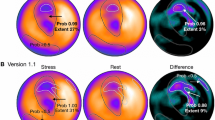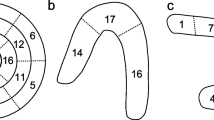Abstract
Background: The aim of this study was to explore the feasibility of using a technique based on artificial neural networks for quality assurance of image reporting. The networks were used to identify potentially suboptimal or erroneous interpretations of myocardial perfusion scintigrams (MPS). Methods: Reversible perfusion defects (ischaemia) in each of five myocardial regions, as interpreted by one experienced nuclear medicine physician during his daily routine of clinical reporting, were assessed by artificial neural networks in 316 consecutive patients undergoing stress/rest 99mTc-sestamibi myocardial perfusion scintigraphy. After a training process, the networks were used to select the 20 cases in each region that were more likely to have a false clinical interpretation. These cases, together with 20 control cases in which the networks detected no likelihood of false clinical interpretation, were presented in random order to a group of three experienced physicians for a consensus re-interpretation; no information regarding clinical or neural network interpretations was provided to the re-evaluation panel. Results: The clinical interpretation and the re-evaluation differed in 53 of the 200 cases. Forty-six of the 53 cases (87%) came from the group selected by the neural networks, and only seven (13%) were control cases (P < 0.001). The disagreements between clinical routine interpretation by an experienced nuclear medicine expert and artificial networks were related to small and mild perfusion defects and localization of defects. Conclusion: The results demonstrate that artificial neural networks can identify those myocardial perfusion scintigrams that may have suboptimal image interpretations. This is a potentially highly cost-effective technique, which could be of great value, both in daily practice as a clinical decision support tool and as a tool in quality assurance.


Similar content being viewed by others
References
Iglehart JK (2006) The new era of medical imaging—progress and pitfalls. N Engl J Med 354:2822–2828
Hesse B, Tagil K, Cuocolo A, Anagnostopoulos C, Bardies M, Bax J et al (2005) EANM/ESC Group EANM/ESC procedural guidelines for myocardial perfusion imaging in nuclear cardiology. Eur J Nucl Med Mol Imaging 32:855–897
Brindis RG, Douglas PS, Hendel RC, Peterson ED, Wolk MJ, Allen JM et al, American College of Cardiology Foundation Quality Strategic Directions Committee Appropriateness Criteria Working Group; American Society of Nuclear Cardiology; American Heart Association. ACCF/ASNC appropriateness criteria for single-photon emission computed tomography myocardial perfusion imaging (SPECT MPI): a report of the American College of Cardiology Foundation Quality Strategic Directions Committee Appropriateness Criteria Working Group and the American Society of Nuclear Cardiology endorsed by the American Heart Association (2005) J Am Coll Cardiol 46:1587–1605. Review. Erratum in: J Am Coll Cardiol 2005, 46:2148–2150
Patel MR, Spertus JA, Brindis RG, Hendel RC, Douglas PS, Peterson ED et al (2005) ACCF proposed method for evaluating the appropriateness of cardiovascular imaging. J Am Coll Cardiol 46:1606–1613
Garcia EV, David Cooke C, Folks RD, Santana CA, Krawczynska EG, De Braal L, Ezquerra NF (2001) Diagnostic performance of an expert system for the interpretation of myocardial perfusion SPECT studies. J Nucl Med 42:1185–1191
Bagher-Ebadian H, Soltanian-Zadeh H, Senior Member, IEEE, Setayeshi S, Smith ST (2004) Neural network and fuzzy clustering approach for automatic diagnosis of coronary artery disease in nuclear medicine. IEEE Trans Nucl Sci 51:184–192
Datz FL, Rosenberg C, Gabor FV, Christian PE, Gullberg GT, Ahluwalia R, Morton KA (1993) The use of computer-assisted diagnosis in cardiac perfusion nuclear medicine studies: a review (Part 3). J Digit Imaging 6(2):67–80
Lomsky M, Richter J, Johansson L, Høilund-Carlsen PF, Edenbrandt L (2006) Validation of a new automated method for analysis of gated-SPECT images. Clin Physiol Funct Imaging 26:139–145
Matsumoto N, Berman DS, Kavanagh PB, Gerlach J, Hayes SW, Lewin HC et al (2001) Quantitative assessment of motion artifacts and validation of a new motion-correction – program for myocardial perfusion SPECT. J Nucl Med 42:687–694
Lomsky M, Richter J, Johansson L, El-Ali H, Åström K, Ljungberg M et al (2005) A new automated method for analysis of gated-SPECT images based on a 3-dimensional heart shaped model. Clin Physiol Funct Imaging 25:234–240
Bishop CM (1995) Neural networks for pattern recognition. Oxford University Press
Rumelhart DE, Hinton GE, Williams RJ (1986) Learning internal representation by errorpropagation. In: Rumelhart DE, McCleland JL (eds) Parallel distributed processing: explorations in the microstructure of cognition. MIT Press/Bradford Books, Cambridge, Mass, pp 318–363
Hanson SJ, Pratt LY (1989) Comparing biases for minimal network construction with backpropagation. In: Touretzky DS (ed) Advances in neural informationprocessing systems. San Mateo, CA: Morgan Kaufmann, p 17185.
Lindahl D, Lundin A, Palmer J, Edenbrandt L (1999) Improved classification of myocardial bull’s-eye scintigrams with computer-based decision support system. J Nucl Med 40:96–101
Piepsz A, Tondeur M, Ham H, De Palma D, Roca I (2007) Interobserver reproducibility in reporting on Tc-99m DMSA scintigraphy. A wide collaborative study. ISCORN 2007 symposium radionuclides in nephro-urology
Kelion AD, Anagnostopoulos C, Harbinson M, Underwood SR, Metcalfe M, British Nuclear Cardiology Society (2000) Myocardial perfusion scintigraphy in the UK: insights from the British Nuclear Cardiology Society Survey 2000. Heart 91(Suppl 4):iv2–iv12
Fletcher BD, Glicksman AS, Gieser P (1999) Interobserver variability in the detection of cervical-thoracic Hodgkin’s disease by computed tomography. J Clin Oncol 17:2153–2159
Acknowledgements
This study was supported by a scholarship from Medicon Valley Association. Conflicts of interests: Kristina Tägil and Lars Edenbrandt are shareholders in EXINI Diagnostics AB, which owns the Exini heart software used in the study.
Author information
Authors and Affiliations
Corresponding author
Rights and permissions
About this article
Cite this article
Tägil, K., Marving, J., Lomsky, M. et al. Use of neural networks to improve quality control of interpretations in myocardial perfusion imaging. Int J Cardiovasc Imaging 24, 841–848 (2008). https://doi.org/10.1007/s10554-008-9329-x
Received:
Accepted:
Published:
Issue Date:
DOI: https://doi.org/10.1007/s10554-008-9329-x




